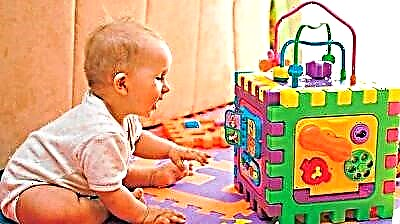Teething in infants is a painful, but very important period. At this time, the baby's behavior can change dramatically. When the first teeth climb, the baby may experience painful sensations and an increase in basal body temperature. In addition, the child has other symptoms. Therefore, all young mothers should know how a child's teeth are teething, and what needs to be done during this period.

The first teeth appear in the baby
When the first teeth are cut in babies
The laying of teeth in children occurs at 3-4 months of pregnancy, that is, even during the prenatal period. This does not mean that the child will be born already with teeth, most often they come out at the age of 5-9 months. Every mommy is interested in the question of when the first teeth are cut in babies, how to help her child and what are the main signs of this phenomenon.
Council. If a child's teeth are not being cut on schedule, they should be shown to the dentist. Only a qualified specialist will be able to understand the child's condition and select, if necessary, an appropriate therapy regimen.
Dates of teething set by doctors
The timing of teething in infants can vary in a fairly wide range, which depends on the individual characteristics of the body, the baby's health, diet, heredity, as well as on many other factors. Doctors note that in most cases, the first teeth appear at the age of 6 to 8 months. Although there are many cases when children have teeth appeared much earlier (in 2-3 months).

You can find out how and when a child's teeth begin to cut teeth from a pediatrician
Council. Pediatric doctors recommend showing the baby to the dentist at the age of 9, then 12 months. When examining a baby, a specialist will assess the condition of the teeth, if they are not there, he can determine or exclude such a rare pathology as adentia. With this disease, the patient does not have the rudiments of milk teeth.
As a rule, the 2 lower incisors are cut first, then the upper middle and lateral incisors, then the lower lateral ones. Sometimes several teeth are cut at once, or they come out one after another with a difference of only a few days. By the age of 2-3 years, a child should have 20 teeth.
Sometimes the order of teething can change, which is associated with the anatomical and physiological characteristics of the body. You should not worry about this. The most important thing is that the teeth erupt, in what order they appear is not so important. Normally, teeth appear in the following order:
- lower central incisors - 5-6 months;
- upper central - 6-8 months;
- upper lateral incisors - 9-11 months;
- lower lateral - 11-12 months;
- first and near molars - 12-18 months;
- canines - 16-22 months;
- distant molars - 1.5-2 years.
Experts identify a number of endo- and exogenous factors that can shift the above-described timing of teething:
- gender;
- features of the diet;
- season;
- lack of vitamin D in the body;
- during pregnancy;
- full-term and maturity of the fetus at birth;
- heredity;
- infectious diseases;
- metabolic disease;
- the presence of pathologies.
Note. The canines and the first incisors are the most painful. Molars, as a rule, climb imperceptibly and are often suddenly discovered by parents.

Teethers help relieve swelling and inflammation
Signs of teeth
When a child's teeth are teething, the symptoms can be completely different:
- inflammation and hyperemia of the gums;
- increase in general body temperature;
- sour smell from the baby's mouth;
- loss of appetite;
- the appearance of snot;
- redness and swelling of the cheeks;
- sleep disturbance;
- children cry often;
- the appearance of white seals on the gums;
- hypersalivation (profuse salivation);
- dysfunction of the gastrointestinal tract;
- coughing.

The appearance of teeth in a baby is accompanied by tearfulness and capriciousness of the child
How to distinguish teething from infection
With teething, the child's immune resistance decreases, he becomes too susceptible to infections. At this stage, it is extremely important for young parents to monitor the health of their baby. They should be able to distinguish between the symptoms of teething from the symptoms of colds and other infectious pathologies.
During the period of teething, a huge amount of saliva accumulates in the oral cavity, which flows down the throat, causing a reflex cough, which intensifies when the child is in a horizontal position. It appears quite rarely - 5-8 times a day. If the cough intensifies, you need to contact a pediatrician who can confirm or, on the contrary, exclude the infection from entering the child's body.
It is important to distinguish the increase in mucous discharge from the nose from the common cold accompanying a cold. If your nasal discharge is yellowish or greenish, you should see your pediatrician. Diarrhea during teething appears due to hypersalivation and activation of intestinal motility. With profuse and frequent diarrhea (3-4 times a day), it is advisable to visit a pediatrician.
Important! During the period of the appearance of teeth in infants, the immune system is weakened, in connection with this, diseases of the oral cavity develop: thrush and stomatitis.
With the appearance of teeth, hyperthermia often occurs. Most pediatricians believe that an increase in basal temperature up to 38 ° C is normal. If the body temperature rises to 38.5-39 ° C, you need to see a doctor. In this case, there is a high probability of the presence of an infectious component in the patient's body.
What happens when a child's teeth are teething
During teething, certain changes occur in the tissues surrounding the tooth. The gingival ridge becomes swollen and soft, small elevations appear on it - dental tubercles, covered with a mucous membrane. The connective tissue of the gums, which lies in the path of movement of the tooth that erupts, gradually contracts and atrophies. The reduced enamel epithelium that covers the crown of the tooth contacts the gum epithelium, breaking through above the crown apex, and it erupts into the oral cavity.
Walking and vaccinations during teething
Many parents turn to the pediatrician with a question: "Is it possible to walk with a child and get him vaccinated during teething?" So, in this difficult period for a child, experts even recommend going for a walk with the baby, because activity and fresh air will be of undeniable benefit. True, you should avoid those places where there are a large crowd of people, so as not to catch an infection. In addition, pediatricians see no reason to avoid vaccinations while a baby is having teeth.

Teeth grow at approximately 2 month intervals
First aid for teething
The capricious, nervous state of the baby requires the utmost patience and attention from adults. Therefore, first aid for teething is very important. In order to calm the child, both folk and modern medications can be used.
Medicines
All medications should be selected according to symptoms. This includes various local anesthetic formulations, antipyretics, immunomodulators, sedative drugs, etc.
Topical analgesics in the form of an ointment or gel can help relieve teething pain. You can buy such a remedy at any pharmacy without a doctor's prescription. Currently, there are a huge variety of gels and ointments from different manufacturers. In addition, homeopathy (candles, drops) can help the child.
Remember! Only the attending physician should prescribe this or that treatment.
The most popular medications are:
- First teeth;
- Dantinorm;
- Pansoral;
- Calgel;
- Dentokind;
- Nurofen;
- Holisal.
Before starting use, you need to carefully study the instructions and read about the dosages of drugs and possible contraindications. The action of anti-inflammatory gels and ointments is longer than that of other analogues.
Folk ways to alleviate the condition
Traditional healers for teething pain relief recommend several effective recipes:
- Chamomile, which also has anti-inflammatory and soothing effects. A more concentrated solution based on this plant can be rubbed into the baby's gums, a less concentrated solution can be drunk.
- Warm tea made from medicinal herbs: lemon balm, chamomile, lavender or catnip.
- Clove oil, which has a unique analgesic effect and relieves inflammation on the baby's gums.
- Valerian is a versatile sedative. The valerian-based solution must be infused for three days. Then regularly rub it into the swollen gums of the baby.
Teethers
When a child's teeth begin to cut, it is an extremely difficult period for him. To ease the general condition of the baby, you can massage the gums. In this case, dentists recommend using teethers. They soothe the baby, activate blood circulation in the affected area, accelerate the process of "pecking" of the tooth.
Note. The toys described above help to form a correct bite, improve and develop fine motor skills of the hands and prepare the child for the chewing process. When choosing a model, you need to pay attention to the excessive hardness of its part, since they can injure the child, in addition, to the quality of the material from which the toy is made.
Teething baby care
When the first teeth appear, dentists recommend cleaning them. In this case, the most convenient tool is the parent's finger, which is wrapped in gauze or bandage. This method can be successfully applied to older children if they refuse to use a toothbrush. Later you can use a special silicone toothbrush.
About a year, you can give your child a toothbrush and try to make the process of brushing your teeth only enjoyable. If he loves this game, then it will be easier to teach him how to seriously engage in this important matter.

Boys have teeth a little later than girls
Parents' mistakes
Fortunately, relieving your toddler's suffering isn't difficult. Before you do anything, you need to make sure that the ailments are actually caused by teething, and not some other disease. If the doctor confirms that the problem is related to the teeth, you need to help the baby calm down and get through this difficult period.
During the period when teeth appear, many parents make the following mistakes:
- give the child apple slices, crackers or cookies;
- press hard on the gums at the point of teething;
- give the baby sugar;
- wipe the oral cavity with alcohol-containing solutions;
- introduce new foods into the baby's diet.
Teething is a rather long and problematic period in a child's development, but a person must go through it. Nothing wrong with that. If the baby is very difficult to tolerate it, you can resort to some methods that can alleviate the condition of the little one.



